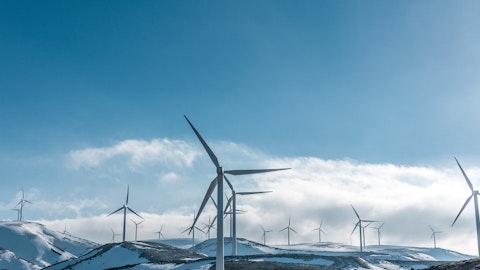But I think it continues to be true that for every dollar of acquisitions that we make, we probably look and pass at an additional $3 to $4 worth of acquisitions. Some of that is we don’t like the asset profile. Some of it is pricing. Some of it is a combination of both. But where we sit here today, even with what you’ve seen in gas prices over the last couple of weeks. To us, it’s still a buyer’s market.
Charles Mead: Got it. Thank you for that added detail.
Operator: Thank you. [Operator Instructions] Our next question comes from the line of Jeff Grampp with Alliance Global Partners. Please proceed with your question.
Jeff Grampp: Morning, guys. The question on the capital allocation question for you guys. So the dividend increase was nice to see as part of the capital return program. So, wondering how you guys think about kind of the optimal balance of dividend growth in kind of the long term versus having sufficient capital to fund the acquisition pipeline and scaling the business, which is obviously still a core part of the business, as.
Chad Stephens: So I’ll let Ralph get into the specific detail of capital allocation. But I think at the highest level, as we came into this year, we were working on the sale of some of our material non-op working interest assets. And we’ve been doing that over the last two or three years, selling non-op working interest assets and redeploying the proceeds into these two core areas in which we’re focused the scoop in the Haynesville. And until we kind of got rid of those material assets, we were selling volumes and cash flow and redeploying into higher margin assets, which will be driving our volumes and cash flow in the coming years. It was difficult for us to meaningfully allocate capital toward an increasing dividend. But now that we’ve divested of a material amount of our non-op working interest assets, and we’re looking into 2024 and our royalty volume growth there, and it represents, as Danielle alluded to, 90% or greater.
We feel a lot better about what our cash flow is going to be. We’re not going to be divesting of any material assets. So it gives us a whole lot more confidence and conviction around allocating a higher portion of our free cash flow, operating cash flow toward a dividend. So I’m going to let Ralph kind of give his thoughts around what we’re doing there.
Ralph D’Amico: Yes, I think that’s right. I mean, I think it always, now that the transformation, for lack of a better term, right, of the company is complete, there is a lot better visibility in terms of future cash flows. And just as a reminder, right, our dividend policy has really been based on a fixed dividend. Right? So we want to make sure that that dividend is safe and sound, regardless of commodity prices and regardless of whatever cycles you may be going and so. Now that the working interest is effectively out the door, I think there is — it’s that much easier. Clearly, every quarter when we discuss with the board the dividend, one of the questions is, can the acquisitions generate a high enough rate of return where it makes sense to deploy that capital towards acquisitions versus return of capital?
Right. And it’s a balance. So this increase doesn’t mean that the acquisition deal flow isn’t good. It just means that, again, we’re trying to find that balance. But if the — if much like in the spring, if the M&A market slows down for whatever reason, we’re not going to force it. We’re going to create more liquidity, pay down debt, and consider, again, more return of capital over time in that scenario as well, if the acquisition market with good returns aren’t there. So it’s something that we think about and discuss with the board on a quarterly basis. We’re very thorough, we’ve been consistent in the past, and I think that’s what we’re going to keep doing going forward.
Jeff Grampp: Great. That makes a lot of sense. I appreciate that. And my follow up, at the risk of beating a dead horse with another acquisition question, I’ll nonetheless go to that topic. So it seems like during the quarter, the acquisitions were pretty spot on with the transactions that you guys announced back in August. So, I guess would seem to imply that the rest of the quarter was a bit quieter for you guys. The commentary on the call today seems very optimistic about deal flow and kind of future potential opportunities. So just wondering to kind of, I guess, reconcile those two thoughts. Is that just a function of kind of where things are in the deal flow funnel in terms of what’s kind of under discussions or just hoping to peel that onion back a little bit more to understand what’s going on the acquisition side?
Ralph D’Amico: There is an array of deals in various different stages. Right? Some have been closed since the quarter end. Some are under PSA, some were evaluating as we speak. Right? And it all adds up to they’re all in different stages. Right? And so none of them by themselves are necessarily material and deserve sort of their own press release. But I would say this quarter is not unlike the last quarter. We’re seeing good activity. We’re capitalizing on it. And it’s certainly a better quarter on the M&A front. On the acquisition front, relative to what the springtime looked like, is how I would characterize it. As we get closer to the end of the year. I’m sure that we’ll discuss that as a group in more detail.
Jeff Grampp: Okay. Great that’s a make a lot of sense.
Chad Stephens: Great to follow up on that. I’m encouraged. We’ve just here in the last week have closed. I think it’s three deals in the $0.5 million to $800,000 range. And as Ralph said, there’s no point in doing a press release on every one of those. It doesn’t do anything for us. So I’m pleased with the activity and the stuff that’s in the queue.
Jeff Grampp: All right, agreed. No, that makes a lot of sense. Thank you guys for the time.
Chad Stephens: Thanks, Jeff.
Operator: Thank you. Our next question comes from the line of Donovan Schafer with Northland Capital Markets. Please proceed with your question.
Donovan Schafer: Hey, guys, thanks for taking the questions and congratulations on the results and the dividend raise. I want to first ask. So, with the dividend increase, as you’ve mentioned, it’s a very serious commitment for you guys. It’s intended to be fixed, so you need to be certain you can underwrite that over a long period of time. So I guess what I’m wondering is, your decision to do the increase this quarter, was it primarily just based on the legacy business before the $13 million in acquisitions and the ones you’ve done since then, that being accretive and positive in nature and the solid economics and all that behind that, could it be done and underwritten with just where it was before, or do you feel like you can do it now in part because of the strength of those acquisitions or was it a combination of both? Just trying to understand if there’s a relationship there.
Chad Stephens: Yes, it’s really as I alluded to a minute ago, we had not done increased dividends earlier because we are divesting of non-op working interest volumes and cash flow associated with material non-op working interest assets. Today, our royalty volumes represent 90%. This time last year, it was about 65% to 70%. So we’ve sold off, and we knew we were going to be selling those assets. So with that divestiture overhang, it was hard to have conviction around allocating a certain percentage of our cash flow toward a dividend when we knew we were going to be selling some of that cash flow. But now we’ve successfully, A sold the non-op working interest assets and B, redeployed those proceeds through this year in some pretty high quality assets that we’re pretty certain we can see through public data and what’s going on the ground that the wells we’ve bought into are going to be completed kind of as we speak, going into the December January time frame, and they’re going to really be adding to our volumes and cash flows, which gave us real conviction around between no longer having a divestiture overhang and good quality assets being developed as we speak to increase the percent of cash flow allocated toward a dividend.


